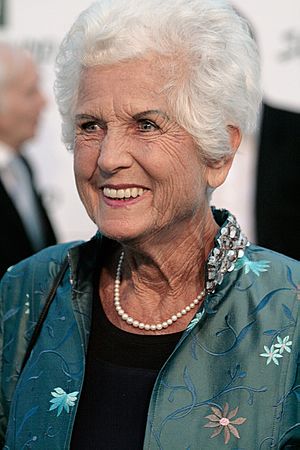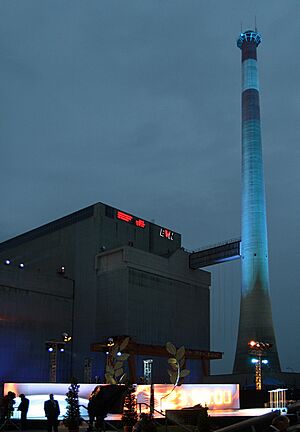Freda Meissner-Blau facts for kids
Quick facts for kids
Freda Meissner-Blau
|
|
|---|---|

Freda Meissner-Blau (2009)
|
|
| Spokeswoman of the Green Party | |
| In office 12 February 1987 – 6 December 1988 |
|
| Preceded by | Office established |
| Succeeded by | Johannes Voggenhuber |
| Personal details | |
| Born | 11 March 1927 |
| Died | 22 December 2015 (aged 88) |
| Political party | The Greens |
Freda Meissner-Blau (born March 11, 1927 – died December 22, 2015) was an important Austrian politician and activist. She was a leading figure in Austria's environmental movement. Freda Meissner-Blau also helped start the Austrian Green Party and was its first federal spokesperson.
Contents
Early Life and Education
Freda Meissner was born in Dresden, Germany, in 1927. She was the youngest of four children. Her mother came from a rich family, and her father was an economist and journalist. Freda grew up in Liberec (now in the Czech Republic) and later in Linz, Austria. Her family was very open-minded and loved nature, culture, and art.
In 1938, her family moved to Vienna. Her father became an editor for a newspaper that spoke out against the Nazi movement. Because of his strong views, he had to flee to the United Kingdom in 1939. To protect the family, Freda's parents divorced. The family then moved back to Liberec.
Freda continued her schooling in Liberec, Vienna, and Dresden. During World War II, many of her friends and family died. She also saw the terrible bombing of Dresden. These experiences made her want to work for good causes and help others.
In 1947, Freda returned to Vienna. She studied communication studies and journalism. While studying, she worked for the American forces in Vienna. Later that year, she visited her father in England. She then studied nursing and medicine in Frankfurt, Germany. In 1953, she married Georges de Pawloff.
Starting Her Career
In the early 1950s, Freda and Georges moved to Central Africa, to what was then the Belgian Congo. They both worked for a German company there. Their first child, Ted Oliver, was born in 1954. While living there, they saw the struggle for independence and the start of the Congo Crisis. These events made Freda care deeply about helping people in developing countries.
In the 1960s, Freda changed careers and moved to Paris. She joined the social science department at UNESCO. One of her jobs was to translate documents about building nuclear power plants. This work made her very interested in nuclear power. She soon formed strong opinions about the dangers it posed to the environment and society. Because of this, she became an activist against nuclear power.
In 1962, Freda and her family returned to Vienna. Her husband worked for the International Atomic Energy Agency. Freda became the general secretary of the new Institute for Advanced Studies. Her twin children, Alexandra and Nicholas, were born in 1963.
In 1968, Freda was back in Paris. She took part in the student and worker protests of that year. She supported many important causes of the time. These included women's rights, civil rights, environmentalism, and democracy. Her marriage with Georges ended around this time. In 1970, she married Paul Blau. They shared many similar beliefs about ethics and society. Paul was a well-known figure in the trade union movement. He was also the editor of a worker's newspaper called Arbeiter-Zeitung.
Activism for Change
Fighting Nuclear Power
In 1972, Freda and Paul returned to Vienna. Freda worked for a large company called OMV. She taught classes and held seminars for employees. This helped her connect with many people in the union movement and the Socialist Party.
In the 1970s, nuclear power was a big topic for environmental activists in Austria. It was a very debated issue in politics. By the late 1970s, the government planned to build six nuclear power plants. The first one was the Nuclear Power Facility at Zwentendorf. As the plant neared completion in 1978, opposition grew stronger. Freda Meissner-Blau became a key leader in the fight against it. She often spoke to the media for the opposition movement. Her husband Paul, along with Stefan Micko, Wolfgang Pekny, and Peter Weish, also led the cause.
In 1978, the socialist Chancellor of Austria, Bruno Kreisky, called a referendum (a public vote) on nuclear power in Austria. This was the first referendum in Austria's Second Republic. People were asked to vote on whether to start up the Zwentendorf plant, which was almost finished. Chancellor Kreisky thought most people would support the plant. The vote was set for November 18, 1978.
Freda Meissner-Blau and other activists from the 'Initiative of Opponents of Atomic Power' (IOeAG) led the campaign for a "No" vote. Their campaign focused on the lack of safety at Zwentendorf. They also argued against nuclear power in general. They highlighted that the plant was only 40 kilometers from Vienna. This helped them show the social dangers of a nuclear accident. Their campaign was well-organized and professional.
As the campaign went on, public opinion began to change. Chancellor Kreisky tried to link the vote to a vote of confidence in his government. But Freda Meissner-Blau and her team were not swayed. To everyone's surprise, the "No" vote won by a small margin of 50.5%. This was a big embarrassment for the government. Afterward, laws were passed to prevent any future nuclear development in Austria. Freda Meissner-Blau became very well-known, and her campaign brought environmental issues into the public eye in Austria.
Saving Hainburg Dam
In 1983, the Austrian government approved plans to build a hydroelectric power plant near Hainburg. The government sped up the approval process, saying it was a special project. Work began in early 1984. However, the plant was to be built in the middle of what is now the Donau-Auen Nationalpark. This is a large and important flood plain, one of the last of its kind in Europe.
By mid-1984, environmental leaders, including Freda Meissner-Blau, started a campaign against the project. They launched a Volksbegehren (citizen's petition) and a media campaign. They wanted to tell the public about the environmental risks. As a leader, Freda Meissner-Blau helped organize large protests in late 1984. On December 8, over 8,000 people held a sit-in at the construction site.
On December 19, the government tried to restart work by using police to remove protesters. This led to violence, and hundreds of protesters were hurt. That evening, Freda Meissner-Blau and other leaders joined a protest in Vienna. Forty thousand people marched against the government. The government then gave in to public pressure. Freda Meissner-Blau and her husband helped negotiate a "Christmas truce" with the government. Over Christmas, thousands of people visited the Hainburg area. By March 1985, a petition with 353,906 signatures against the plant was given to parliament. This petition was successful, and the government had to drop the plan.
Political Career
Green Movement and Presidential Campaign
The green political movement in Austria began after the 1978 nuclear referendum. But it really took off after the Hainburg dam victory. Before this, there were two main Green political groups: the Alternative List of Austria (ALÖ) and the United Greens of Austria (VGÖ). These groups were not well organized and often disagreed.
After the Hainburg victory, efforts were made in 1984 and 1985 to unite the movement. The goal was to have a single list of candidates for the 1987 elections. However, this attempt caused more problems. The VGÖ refused to join, and the ALÖ split into two groups.
In October 1985, a moderate part of the former ALÖ formed the Citizen's Parliamentary Initiative (BIP). They wanted to create a more professional Green political group. Freda Meissner-Blau and other Green leaders attended the first meeting on October 26, 1985. Freda was well-spoken, respected, and known across the country for her environmental work. The BIP nominated her to run as the first Green candidate for President of Austria. This happened at a meeting in Graz on January 6, 1986.
In February, the left-wing part of the former ALÖ formed their own group, the Green Alternative Rally (GRAS). But the BIP gained momentum as other Green groups joined them. The media paid a lot of attention to Freda Meissner-Blau before the May Presidential vote. The movement gained even more support after the Chernobyl disaster in April. On May 4, Freda Meissner-Blau received 5.5% of the vote. This was the best result for the Green movement so far. Her campaign made her the top figure in the movement.
Joining Parliament
In mid-1986, the government coalition collapsed. New elections were called for November 23, 1986. There was pressure for the Green movement to unite for the election. Freda Meissner-Blau became the most popular choice to lead the candidates' list. She led the campaign under the name The Green Alternative – List Freda Meissner-Blau.
Freda Meissner-Blau was a popular and unifying leader. However, not all Green groups joined her list. On October 4, GRAS, the largest Green group not yet committed, voted on whether to join. They were divided, and the vote went against Freda Meissner-Blau. Despite this, most of the Green movement supported her leadership. They ran a strong campaign that presented a professional and real political choice to the Austrian public for the first time.
The 1986 election was a big surprise in Austrian politics. Both major parties lost seats to the smaller Greens and the Freedom Party. The Greens won 4.8% of the votes, which was enough to get them into parliament. Eight candidates, including Freda Meissner-Blau, were elected to the Austrian National Council.
Once in parliament, the elected members formed a formal party: the Austrian Green Party. Freda Meissner-Blau was chosen as the first federal spokesperson and leader of the party. This happened at the first party meeting in Klagenfurt on February 12, 1987. The party faced some challenges and internal disagreements at first. Freda Meissner-Blau was a popular and calm leader. She served on several parliamentary committees. Through her speeches and work on laws, she helped the party speak with one voice and look professional. After two years as leader, she retired from the party on December 6, 1988.
International Human Rights Tribunal
In June 1995, Freda Meissner-Blau led the first International Human Rights Tribunal in Vienna. This tribunal focused on discrimination against certain groups of people in Austria from 1945 to 1995. A group of human rights activists found that Austria had discriminated in several cases. Because of this and other efforts, all laws that discriminated against these groups in Austria were removed between 1996 and 2005.
Retirement and Legacy
After leaving Parliament, Freda Meissner-Blau worked as a consultant for different international organizations. She also wrote and gave speeches at various conferences. In 1991, she received the Konrad Lorenz Prize for her environmental work. She also received a Lifetime Achievement Nuclear-Free Future Award and was one of the first winners of the Save the World Award in 2009. Her husband Paul died in October 2005. Freda Meissner-Blau passed away on December 22, 2015, at the age of 88.
See also
 In Spanish: Freda Meissner-Blau para niños
In Spanish: Freda Meissner-Blau para niños
- Anti-nuclear movement in Austria
- Hildegard Breiner
- The Greens – The Green Alternative
- Nuclear-Free Future Award


